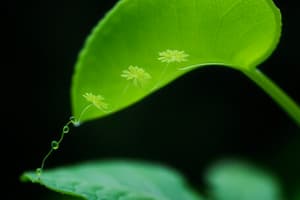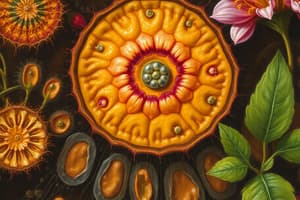Podcast
Questions and Answers
Which of the following characteristics is NOT a defining feature of living things?
Which of the following characteristics is NOT a defining feature of living things?
- Reproduction
- Growth
- Response to stimuli
- Movement (correct)
Which of the following is a primary function of the cell wall in a plant cell?
Which of the following is a primary function of the cell wall in a plant cell?
- Controlling the movement of substances into and out of the cell
- Providing structural support and protection (correct)
- Producing energy for the cell
- Storing genetic information
What is the primary function of the chloroplast in a plant cell?
What is the primary function of the chloroplast in a plant cell?
- Storing genetic information for the cell
- Generating energy from sunlight to produce food (correct)
- Controlling the movement of substances into and out of the cell
- Providing energy for the cell
Which of the following best describes the role of the nucleus in a cell?
Which of the following best describes the role of the nucleus in a cell?
Which of the following is NOT a characteristic of a compound microscope?
Which of the following is NOT a characteristic of a compound microscope?
Which of the following is an example of how living things respond to changes in their environment?
Which of the following is an example of how living things respond to changes in their environment?
What is the main difference between plant cells and animal cells?
What is the main difference between plant cells and animal cells?
What is the main function of a cell's nucleus?
What is the main function of a cell's nucleus?
Flashcards
Characteristics of Living Things
Characteristics of Living Things
Growth, reproduction, energy use, response to environment, lifespan, and waste production.
Growth and Repair in Living Things
Growth and Repair in Living Things
Living organisms increase in size and can repair themselves.
Energy Requirement
Energy Requirement
Living things need energy to survive; plants use sunlight, animals eat to obtain energy.
Response to Environment
Response to Environment
Signup and view all the flashcards
Lifespan
Lifespan
Signup and view all the flashcards
Waste Production
Waste Production
Signup and view all the flashcards
Compound Microscope
Compound Microscope
Signup and view all the flashcards
Nucleus in a Cell
Nucleus in a Cell
Signup and view all the flashcards
Study Notes
Characteristics of Living Things
- Living things grow in size, reproduce, and repair themselves
- Living things need energy
- Living things react to changes in their environment
- Living things have a lifespan
- Living things produce waste
Plant Growth
- Plants and animals grow larger as they age
- Plants make their own food using sunlight
- Plants can repair damaged parts
- Animals eat plants or other animals for energy
Living Things and the Environment
- Animals may escape predators or seek food
- Plants grow towards water
- Living things live, grow, and die.
- Living things release waste into the environment
Compound Microscopes
- Compound microscopes are used to view cells.
- Microscopes use lenses and light to magnify specimens.
- Magnification is how much larger a specimen appears.
- Field of view is the part of the specimen seen through the eyepiece.
Plant and Animal Cells
- Nucleus is the control center of a cell, containing genetic information
- Nucleus controls all the cell activities.
- Chromosomes carry instructions for the cell's functioning
- Plant cells have cell walls (support and protection)
- Plant cells contain chloroplasts (photosynthesis)
Cell Movement
- Flagella and cilia move animal cells.
- Flagella are tall structures.
- Cilia are hair-like projections.
Studying That Suits You
Use AI to generate personalized quizzes and flashcards to suit your learning preferences.




